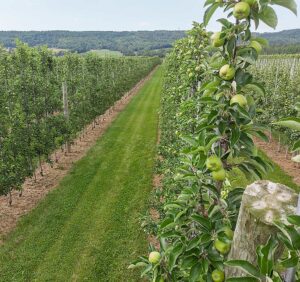—story and photo by Matt Milkovich
—photo by TJ Mulllinax
—graphic by Jared Johnson

Larry Lutz doesn’t worry too much about vigor in Nova Scotia. The Canadian province’s mild climate and relatively short growing season don’t exactly encourage trees to be vigorous, and if they are, they can be calmed with pruning practices.
In the first year after planting, trees tend to grow a few large, unproductive vertical branches. Lutz prunes out the large vertical branches in the second and third year to encourage new growth that can be trained into a more planar system.
He also cuts back dominant lateral branches on young trees. After that, the trees tend to grow many smaller branches laden with buds.
Those are just a couple of the lessons Lutz, a grower and former tree fruit specialist with the Scotian Gold cooperative, has learned about growing apples in Nova Scotia over the past 35 years.

Lutz is one of the main drivers of the modernization of the Nova Scotia apple industry. When he came back to the family farm in 1989, the industry had been “limping along” for decades, he said, with old plantings of McIntosh and processing blocks. Growers couldn’t afford to refurbish their orchards, and their kids had no reason to stick with the family farm.
Today, with Lutz poised to pass the family farm baton to his son and son-in-law, Nova Scotia’s apple orchards are thriving as growers are reinvesting in their farms and their children are returning to carry on the legacy. The change can mostly be ascribed to progressive, high-density planting approaches adopted by Lutz and others, along with Honeycrisp profits.
Grower Henry Wohlgemuth said Lutz was his biggest influence during his farm’s transition to progressive apple growing.
“He’ll tell you what you can get by with, and what you can’t,” Wohlgemuth said. “He’s a straight shooter. That’s what I like about him.”
These days, Nova Scotia orchards are full of Honeycrisp, Gala, Ambrosia, Minneiska (marketed as SweeTango), Rave and other varieties for fresh sales. New plantings are spaced 2 or 2.5 feet by 11 or 12 feet on Malling, Geneva and Budagovsky rootstocks. Trees grow to 10 or 12 feet, guided by wooden posts and wires.
The transition to high-density happened fairly quickly. Once the Honeycrisp profits started rolling in during the late ’90s and early 2000s, Lutz and other Nova Scotia growers didn’t waste much time pulling out old blocks and planting new ones. Lutz grows about 140 acres of apples now.

For the past decade, most of his trees have been planted on M.26, which grows well there and doesn’t sucker as badly as other rootstocks. To avoid suckering, growers plant their trees deeper than do others in more vigorous regions.
Lutz and others have learned a few lessons about adapting modern growing techniques to Nova Scotia’s unique maritime climate. The province’s shorter days and lower heat units lessen tree vigor, but that tends to give the trees a higher bud count and makes them easier to manage. In general, growers don’t have to worry about drought, hail or spring frosts, so they don’t have to spend money on irrigation, nets or frost fans.
The relatively cool temperatures lessen bitter pit risk, and even fire blight wasn’t much of a problem until a decade ago, when a hurricane spread it around the province, Lutz said.
Government rules no longer allow Telone (1,3-dichloropropene) for soil fumigation, so growers now focus on methods like deep ripping and compost to regenerate soil and combat replant disease, he said.
Lutz’s son, Sam, and his son-in-law, Cassian Ferlatte, are in the process of taking over the family orchard. Lutz is very happy about that. His advice to them and all new growers is to keep their debt load manageable. The Nova Scotia apple industry hasn’t been a magnet for outside investment, but that’s not necessarily a bad thing.
“Plan for the price of apples being less rather than more,” Lutz said. “Things can go south in a hurry in this business.” •








Leave A Comment